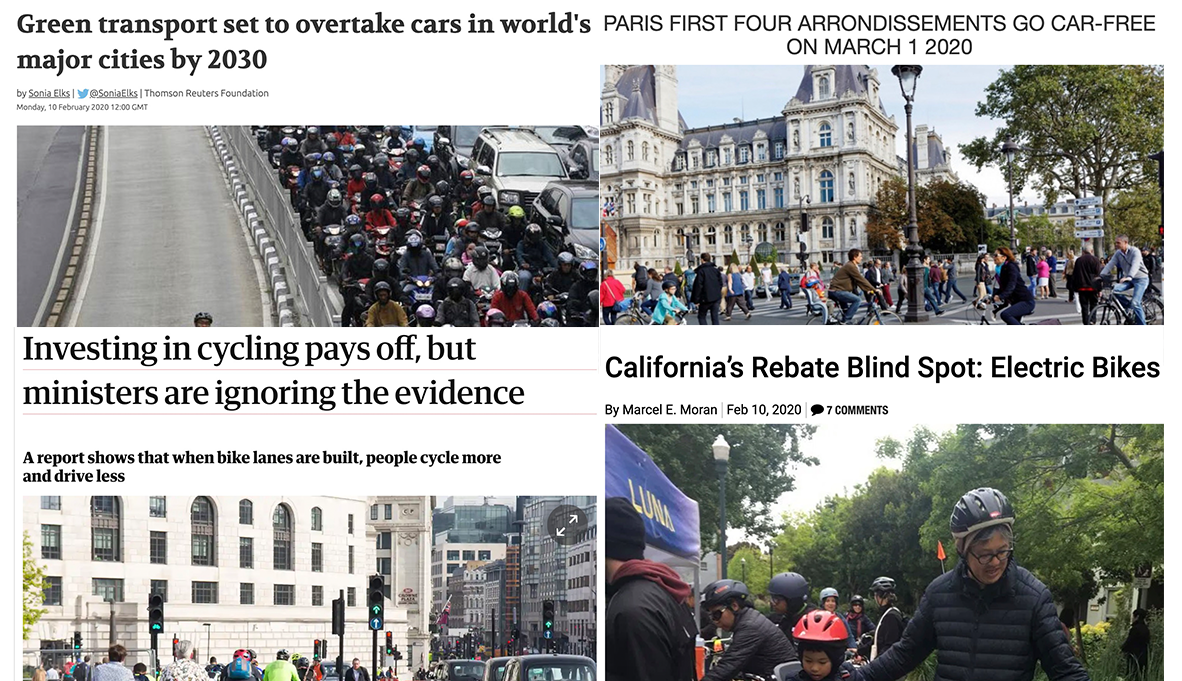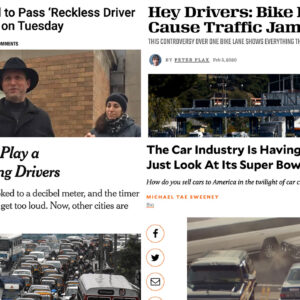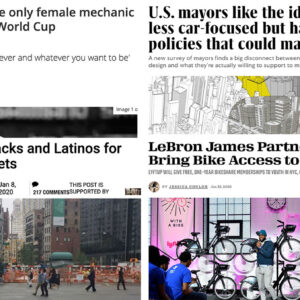Sponsored by Endurance Physical Therapy + Bike Fit Studio.
Welcome to the week. Here are the most notable items BikePortland readers and editors came across in the past seven days…

Bike lane nailer sentenced: A guy who admitted scattering nails in bike lanes has been given 30 days behind bars. Someone should give him a stack of bike tubes to repair while he’s in there.
A handle on speed: Oregon is not the only state looking to change the way it approaches the scourge of high speeds. California might be leading the way with its reforms.
Inclusive or nah?: Seattle Bike Blog has released a survey from Seattle Pedalers Looking for Action to Inform (SPLAIN) that rates every local bike shop on how women, trans, femme, and gender nonconforming people feel while shopping.
Sunday Parkways on steroids: Paris Mayor Anne Hidalgo continues to show what real leadership looks like with announces that four arrondissements (quadrants) will go carfree once per month.
Cars are over: A study based on data from 31 cities leads researchers to believe that private car trips will make up less than half of all journeys by 2030 as biking, walking, transit, and other vehicles take over.
Advertisement
Deadly street: Venice Blvd in Los Angeles, the street where actor Orson Bean was killed, is well known for the dangers it presents to users.
E-bike rebates: If your electric vehicle (EV) policy doesn’t encourage/promote/subsidize electric bikes, you are doing it wrong.
Biking ROI: Years of investment in real cycling infrastructure in the United Kingdom are bearing fruit.
AVs and organs: We are so lucky to have tech geniuses thinking ahead to problems with an autonomous vehicle future: Such as where hospitals will get organs when so few people die in car wrecks.
Tweet of the Week: I’m very intrigued by New York City’s Reckless Driver Accountability Act. Why? This thread from Aaron Naparstek lays it out very well:
I think the Reckless Driver Accountability Act is a big deal and represents a real paradigm shift in the way we do traffic enforcement… https://t.co/IoxJMcJrkt
— Aaron Naparstek (@Naparstek) February 11, 2020
— Jonathan Maus: (503) 706-8804, @jonathan_maus on Twitter and jonathan@bikeportland.org
— Get our headlines delivered to your inbox.
— Support this independent community media outlet with a one-time contribution or monthly subscription.







Thanks for reading.
BikePortland has served this community with independent community journalism since 2005. We rely on subscriptions from readers like you to survive. Your financial support is vital in keeping this valuable resource alive and well.
Please subscribe today to strengthen and expand our work.
The “Night-Time Nailer” story should be prominently placed on the website. This is big and good news.
One would also be curious to learn WHY he felt like doing this. Or not?
Some people need villains in their life in order to justify their unhappiness instead of resolving it internally. In other words, everyone wants to believe they are victim in some way.
Thanks for that pseudo-psychology speculation. Sounds like right-wing nonsense to me.
That observation works equally well for conservatives.
Ever notice that the core message of conservative messaging is that something is being “taken away” for “hard working” Americans?
Ya I’m a little disappointed that there’s been no reporting on why he was doing it and if he was also responsible for nails in other locations like Interstate.
It actually was mentioned in a different article : ““By Mr. Wilson’s recollection, he has thrown nails over 50 times onto our busy streets over the last couple of years,” police said in a news release at the time.
Wilson’s early morning ritual — always done before sunrise so as to avoid detection — was in response to drivers he felt were rude or had slighted him, Brock said.
“It was his form of anger management. It made him feel better,” Brock said. “It doesn’t make a whole lot of sense, but that’s what he said.”
The man also told police he would buy $40 buckets of nails at a Home Depot outside of Oregon City to cover his tracks, according to the prosecutor. Often, Wilson would go through three buckets of nails in a few months.”
(here: https://www.oregonlive.com/news/2020/02/man-who-repeatedly-tossed-handfuls-of-nails-onto-oregon-city-streets-gets-30-days-in-jail.html?utm_source=Newsletter&utm_medium=Newsletter%20-%20Morning%20Briefing&utm_campaign=omg_thu_021320)
I missed that one thank you. It sounds like he might not be the culprit for the nails on Interstate then unless he drives around there a lot. I seem to recollect people reporting the nails were generally put in the same places too.
No indication he threw them in PDX, but it’s assumed so, I guess. I just wonder what he does for a living, what his story is, etc.
I have not encountered any nails on my commute since the nailer was arrested. my commute use to have nails at least once a week. Correlation is not causation that is just my observation.
amazing timing with the nighttime nailer story; I was just wondering how to find out what happened to this guy! As I rode home on Friday evening, I was appreciating the nail-free bike lane and realizing that there had been no new nails since he got busted.
AVs will still kill people. And if, by some miracle, they don’t, we can always go back to back-alley black market organ harvesting.
I am backing off on my black market organ harvesting until they get the Corona virus under control.
Yes, AVs will still kill people (and I think all of us know, already have). The issue isn’t binary, it’s that the number of people killed by cars can reasonably be expected to decline drastically, reducing the number of organ donors well below demand for their organs.
There are no Level 5 AV’s yet. Most of the partial AV (Level 3?) fatal crashes are attributed to driver error not understanding that there are no Level 5 AVs yet.
I find it odd that people will lament that someone will die if they don’t an organ transplant from someone who didn’t die in a car crash. Seems kind of like a zero-sum situation to me.
I just spent 30 minutes looking for a pic, couldn’t find it, but I have crossed Venice Blvd in Culver City dozens of times this year. I’m thinking of one specific intersection that pretty much defines it- 9 lanes wide. There’s only a crosswalk on 3 sides of the intersection, so there’s always a ton of hassle crossing there.
There are several other pedestrian-hostile places within walking distance of there. Good times.
“Some people, including a few task force members, have argued that speed limits themselves have very little effect on safety, but the researchers found the opposite. ”
“It assumes that “most drivers will drive at a safe and reasonable speed based on the road conditions”
Two talking points I see brought up by auto lobbyists all the time. Even occasionally on these forums. I’m convinced they figure if they just keep repeating it enough people will believe it and oppose traffic calming efforts so the auto stays the most convenient way to get around.
The original 85th percentile rule was for rural four lane highways and is misapplied to urban environments that have much more varied users. It also predates modern vehicle design that isolates vehicle occupants from the dangers of a crash and roadway feedback that formerly communicated danger to the vehicle operator, apart from the odd notion that drivers that have rarely seen a crash or been involved in one have full understanding of how fast things can go wrong (sort of the basis for ‘reasonable’ driver).
The “Nightime Nailer” was targeting car drivers according to OregonLive.
https://www.oregonlive.com/news/2020/02/man-who-repeatedly-tossed-handfuls-of-nails-onto-oregon-city-streets-gets-30-days-in-jail.html
“Wilson’s early morning ritual — always done before sunrise so as to avoid detection — was in response to drivers he felt were rude or had slighted him, Brock said.”
Inclusive or Nah? My brother’s custom bike manufacturing operation, Hampsten Cycles Hampsten.com is listed in the middle. I wonder, are there are other Seattle manufacturers being listed as “bike shops” too on this survey?
David,
Davidson/Kullaway is included in the survey–surprisingly, R&E, a shop that’s both retail and mtg’ing, formerly woman-owned and known woman-friendly in a big way, wasn’t even included in the survey.
Timely Salon article on pedestrian and bike traffic fatalities:
https://www.salon.com/2020/02/09/toll-continues-to-mount-for-pedestrians-and-bicyclists-the-victims-in-one-in-five-traffic-deaths_partner/
THIS:
“Consistent, kerb-protected routes are a better investment than the less ambitious white-paint-on-the-road routes, if you want more people using them. The most successful routes were away from motor traffic entirely…. On Manchester’s Broughton cycleway, a lower-quality route “protected” by plastic wands and “armadillos” (little rubber blocks bolted to the road), there was, however, little change.”
The article highlights the kind of infrastructure we need to get the 25% “interested but concerned” riders to actually bike on a regular basis. They own a bike, likely a piece of crap that is poorly maintained, but they expect to bike much like they drive: They are looking for a set of roadway infrastructure that is a) networked; b) continuous; c) hierarchical; and d) predictable. What these British examples, as well as the Dutch, show is that once you have built such (an expensive) predictable network, your ridership will more likely get to the 25% you are looking for.
When the 85% who obey the law drive, they typically leave their homes on a residential street, dive a few blocks to a collector, then to an arterial where they may do their errands or work, but more likely proceed to a freeway for a distance, then an arterial and a collector to their destination. In general, Joe Sixpack doesn’t take a series of back residential streets to his destination.
Our ideal bike network should be similar: The freeway replaced with a continuous bike path or MUP completely separated from automobile and rail traffic, like the Amazon trail in Eugene or the Eastbank Esplanade in Portland (and the towpaths mentioned in the article). You’d leave your home on a quiet residential street, then turn onto the local greenway or bicycle boulevard (collector), then connect to a buffered bike lane on a minor arterial, then a protected cycletrack that takes you to the separated bike path superhighway, then the reverse process to your destination. At some point you’ll need to ride on a busy urban street; it’s bicycle facilities should be appropriate to the speeds and congestion on each street (there are streets where a basic painted bike lane are appropriate, but not as a substitute for a higher order of facility.)
People want a predictable system and network – you do A, that leads to B, then C – without having to put a lot of thought into where they need to go (I’m thinking about Becky Jo’s column on this.)
The reality is that most communities, mine included, cannot develop such infrastructure without a lot more funding and a radical rethink of traffic patterns, far more than what has been allocated thus far. It also requires that local bike plans have a hierarchical set of bike routes, which Portland’s bike plan noticeably does not (to be sure, most bike plans don’t either). When we tried to create a hierarchy of routes for East Portland in the EPIM process, we got a lot of staff resistance from PBOT.
Comment of the week. Long but totally worth following to the end.
This is why I’m a diehard for the much-maligned Sullivan’s Gulch Trail. It’s an opportunity to put in place a top-level route that connects jobs, underserved populations, tourist destinations, sports arenas, and thousands of hotel rooms. Where else in the Portland area can PBOT deal with one landowner to pull this off? Let’s give the railroad a pony, or a bottle of nice Scotch, and make it happen.
Yes.
When I drift off at my desk, this is the dream I have.
For too long, the flattest, most direct routes have been reserved as cars-only; if not legally, then by intimidation. When we do build MUPs that connect far-flung destinations, A) they are MUPs, on which anyone can walk dogs, play marbles, or take up literal residence, B) they are often too narrow to facilitate passing and two-way travel, C) they seem to fall under nobody’s jurisdiction for safety patrol or maintenance, and different jurisdictions may close them on a whim, deeming them to be “parks”.
IMO, one of the main reasons underlying the creation of “almost” bike infrastructure is that it is still viewed as for recreation only (or at least mainly)—a place to “ride”, for the sake of riding, rather than a route to use for travel between destinations. “Fast bikes” are berated for using such facilities for “training”, when in reality, a “bike superhighway” should be designed to allow for such speeds, whether for recreation or commuting, potentially by e-bike.
It’s pretty much impossible to create the ‘ideal protected bikeway’ in a street grid with frequent intersections and driveways, the only places this type of bikeway can be created is someplace like along the Willamette River or through Sullivan’s gulch, with few if any cross streets and intersections. Dreaming about it beyond this is nothing but dreaming, because it isn’t going to happen.